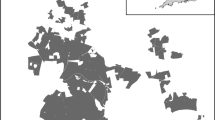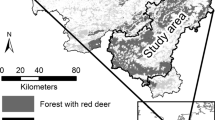Abstract
Deer populations have increased considerably in the last decades, modifying the growth and regeneration patterns of many tree species. However, the impact of antler rubbing (fraying) by deer has received very little attention. Here, we analyze the impact of deer rubbing on pines (tree selection, damage intensity, growth and successful reproduction) in a natural (uneven-aged) Pinus pinaster population where red deer (Cervus elaphus) are abundant. We developed a probability model that shows a nonlinear relationship between dendrometric variables (tree height and diameter) and the probability of rubbing damage. Intermediate-sized trees were clearly selected, reaching maximum probability of being rubbed for trees 1.5 m high and 11 cm basal diameter. However, intensity of rubbing showed a more linear pattern, where small-sized trees were more heavily damaged, followed by medium and large trees. Interestingly, both rubbed and non-rubbed trees significantly grew in basal diameter whereas growth in height and dbh (diameter at 1.3 m high) was strongly negatively affected by rubbing. This dissimilar growth affected plant shape and tree quality and prevented young trees from advancing onto the reproductive stage. Reproduction success (probability of cone production) was strongly reduced (fivefold) when rubbing affected >25 % of the trunk circumference. Sustainability of rubbing was defined based on plant shape and reproduction success through an increasing 0–5 damage rank. In 6 years the average rubbing damage increased from 3.1 to 4.1, reaching unsustainable levels of rubbing. Recommended management practices include tree protection and adding natural or artificial decoy posts of the most deer-preferred diameters and heights.






Similar content being viewed by others
References
Acevedo P, Ruiz-Fons F, Vicente J, Reyes-García AR, Alzaga V, Gortázar C (2008) Estimating red deer abundance in a wide range of management situations in Mediterranean habitats. J Zool 276:37–47
AEMET (2011) Atlas climático ibérico; temperatura del aire y precipitación (1971–2000). State Meteorological Agency, Spain
Apollonio M, Andersen R, Putman R (2010) European ungulates and their management in the 21st century. Cambridge University Press, Cambridge
Aranda Y, Orueta JF, Fandos P (1995) Análisis de la selección de escodaderos por parte del ciervo (Cervus elaphus L.) en ambiente mediterráneo. Ecología 9:395–401
Azorit C (2005) La importancia de la gestión de los ciervos en Sierra Morena oriental. Real academia de ciencias veterinarias de Andalucía oriental. Anales de la Real Academia 18(1):15–21
Barrios-Garcia MN, Relva MA, Kitzberger T (2012) Patterns of use and damage by exotic deer on native plant communities in northwestern Patagonia. Eur J Wildl Res 58:137–146
Burnham KP, Anderson DR (2002) Model selection and multimodel inference: a practical information-theoretical approach, 2nd edn. Springer, New York
Campos P, Caparrós A, Rodríguez Y (2001) Towards the dehesa total income accounting: theory and operative monfragüe study cases. Invest Agr Sist Rec For 1:45–69
Charco J, Gil L (2005) Estudio del pinar de Pinus pinaster Ait. de Navalmanzano (Ciudad Real). Cartografía, inventario, caracterización del recurso genético y propuesta de actuaciones para su conservación. Universidad Politécnica de Madrid
Christensen RHB (2013) Ordinal—regression models for ordinal data. R package version 2013.9–30. http://www.cran.r-project.org/package=ordinal/
Christensen RHB, Brockhoff PB (2013) Analysis of sensory ratings data with cumulative link models. J Soc Fr Statistique 154(3):58–79
Côté SD, Rooney TP, Tremblay JP, Dussault C, Waller D (2004) Ecological impacts of deer overabundance. Annu Rev Ecol Evol Syst 35:113–147
Cumming HE (1974) Fraying behaviour and management of roe deer. In: Geist V, Walther F (eds) Behaviour of ungulates. International Union for the Conservation of Nature, New Series 2, Morges, Switzerland, pp 813–829
Díaz-Fernández PM (1994) Relations between modern pollen rain and mediterranean vegetation in Sierra Madrona (Spain). Rev Paleobot Palynol 82:113–125
European Environment Agency (EEA) (2010) Europe’s ecological backbone: recognising the true value of our mountains. EEA Report No 6/2010. EEA, Copenhagen
Fernández-Olalla M, Muñoz-Igualada J, Martínez-Jauregui M, Rodríguez-Vigal C, San Miguel-Ayanz A (2006) Selección de especies y efecto del ciervo (Cervus elaphus L.) sobre arbustedos y matorrales de los Montes de Toledo, España central. Invest Agr: Sist Recur For 15(3):329–338
Fernández-Ortiz JJ (2007) Propuesta de plan de gestión de los mamíferos fitófagos en el Parque Nacional de Cabañeros. Master Thesis. Universidad Politécnica de Madrid. Madrid
Fierro Y, Gortázar C, Landete-Castillejos T, Vicente J, García A, Gallego L (2002) Baseline values for cast antlers of Iberian red deer (Cervus elaphus hispanicus). Z Jagdwiss 48:244–251
Freckleton R (2011) Dealing with collinearity in behavioural and ecological data: model averaging and the problems of measurement error. Behav Ecol Sociobiol 65:91–101
García-Rayego JL (2006) Modelados de detalle en roquedos cuarcíticos de áreas de montaña media apalachense de la Meseta sur y Sierra Morena oriental. Ería 71:269–282
Geist V (1998) Deer of the World. Mechanicsburg Press, Mechanicsburg
Gerhardt P, Arnold JM, Hacklander K, Hochbichler E (2013) Determinants of deer impact in European forests—a systematic literature analysis. For Ecol Manage 310:173–186
Gil L, Gordo J, Alía R, Catalán G, Pardos JA (1990) Pinus pinaster Aiton en el paisaje vegetal de la Península Ibérica. Ecología 1:469–495
Gill RMA (1992) A review of damage by mammals in north temperate forests: 1. Deer. Forestry 65:45–169
Gordon IJ, Hester AJ, Festa-Bianchet M (2004) The management of wild large herbivores to meet economic, conservation and environmental objectives. J Appl Ecol 41:1021–1031
Greene WH, Hensher DA (2010) Modeling ordered choices: a primer. Cambridge University Press, Cambridge
Hannan MJ, Whelan J (1989) Deer and habitat relations in managed forests. In: Putman JR (ed) Mammals as pests. Champman & Hall, London
Johansson A, Liberg O (2000) Functional aspects of marking behaviour by male roe deer (Capreolus capreolus). J Mammal 77:558–567
Johansson A, Liberg O, Wahlstrom LK (1995) Temporal and physical characteristics of scaping and rubbing in roe deer (Capreolus capreolus). J Mammal 76:123–129
Kile TL, Marchinton RL (1977) White-tailed deer rubs and scrapes: spatial, temporal and physical characteristics and social role. Am Midl Nat 97:257–266
Kuiters A, Mohren G, Van Wieren S (1996) Ungulates in temperate forest ecosystems. For Ecol Manage 88:1–5
Leibold MA, Chase JM, Shurin JB, Downing AL (1997) Species turnover and the regulation of trophic structure. Annu Rev Ecol Syst 28:467–494
Macaulay LT, Starrs PF, Carranza J (2013) Hunting in managed oak woodlands: Contrasts among similarities. In: Campos P, Huntsinger L, Oviedo JL, Starrs PF, Diaz M, Standiford RB, Montero G (eds) Mediterranean oak woodland working landscapes. Springer, Berlin, pp 311–350
Macmillan DC, Phillip S (2008) Consumptive and non-consumptive values of wild mammals in Britain. Mammal Rev 38:189–204
Martin JL, Stockton SA, Allombert S, Gaston AJ (2010) Top-down and bottom-up consequences of unchecked ungulate browsing on plant and animal diversity in temperate forests: lessons from a deer introduction. Biol Invasions 12:353–371
Massei G, Bowyer RT (1999) Scent marking in fallow deer: effects of lekking behaviour on rubbing and wallowing. J Mammal 80:633–638
Miller KV, Kammermeyer KE, Marchinton RL, Moser EB (1987) Population and habitat influences on antler rubbing by white-tailed deer. J Wildl Manage 51:62–66
Moreno-Gómez A, Rodríguez-Vigal C, Ferrandis-Gotor P, Heras-Ibáñez J (2001) Impacto del escodado del ciervo (Cervus elaphus L.) sobre la cornicabra (Pistacia terebinthus L.) en «Quintos de Mora» (Los Yébenes, Toledo). Invest Agr Sist Recur For 10(1):81–93
Mysterud A (2010) Still walking on the wild side? Management actions as steps towards “semi-domestication” of hunted ungulates. J Appl Ecol 47:920–925
Nielsen DG, Dunlap MJ, Miller KV (1982) Pre-rut rubbing by white-tailed bucks: nursery damage, social role, and management options. Wildl Soc Bull 10:341–348
Perea R, Gil L (2014) Tree regeneration under high levels of wild ungulates: the use of chemically vs. physically-defended shrubs. For Ecol Manage 312:47–54
Perea R, Girardello M, San Miguel A (2014) Big game or big loss? High deer populations are threatening woody plant diversity and vegetation dynamics. Biodivers Conserv 23:1303–1318
Perea R, Perea-Garcia-Calvo R, Díaz-Ambrona CG, San Miguel A (2015) The reintroduction of a flagship ungulate Capra pyrenaica: assessing sustainability by surveying woody vegetation. Biol Conserv 181:9–17
Ramos JA, Bugalho MN, Cortez P, Iason GR (2006) Selection of trees for rubbing by red and roe deer in forest plantations. For Ecol Manage 222:39–45
Reimoser F, Armstrong H, Suchant R (1999) Measuring forest damage of ungulates: what should be considered. For Ecol Manag 120:47–58
Rooney TP (2009) High white-tailed deer densities benefit graminoids and contribute to biotic homogenization of forest ground-layer vegetation. Plant Ecol 202:103–111
Rooney TP, Waller DM (2003) Direct and indirect effects of deer in forest ecosystems. For Ecol Manage 181:165–176
Royston P, Ambler G (1998) Multivariable fractional polynomials. Stata Tech Bull 43:24–32
Rubiales JM, García-Amorena I, García-Álvarez S, Morla C (2009) Anthracological evidence suggests naturalness of Pinus pinaster in inland southwestern Iberia. Plant Ecol 200:155–160
Ruiz-Benito P, Álvarez-Uria P, Zavala MA (2009) 9540 Pinares mediterráneos de pinos mesogeanos endémicos. In: VV.AA. (eds) Bases ecológicas preliminares para la conservación de los tipos de hábitat de interés comunitario en España. Ministerio de Medio Ambiente, y Medio Rural y Marino, Madrid, 112 pp
San Miguel A, Perea R, Fernández-Olalla M (2010) Wild ungulates vs. extensive livestock. Looking back to face the future. Options Meditérr 92:27–34
Sánchez-Prieto CB, Carranza J, Pulido FJ (2004) Reproductive behavior in female Iberian red deer: effects of aggregation and dispersion of food. J Mammal 85:761–767
Scarascia-Mugnozza G, Oswald H, Piussi P, Radoglou K (2000) Forests of the Mediterranean region: gaps in knowledge and research needs. For Ecol Manage 132:97–109
Schloeth R (1968) Analysis of rubbing and fraying by red deer in an alpine habitat (Swiss National Park). Swiss Comm Nat Sci 11:75
Shelton AL, Henning JA, Schultz P, Clay K (2014) Effects of abundant white-tailed deer on vegetation, animals, mycorrhizal fungi, and soils. For Ecol Manage 320:39–49
Smart J, Sutherland WJ, Watkinson AR, Gill JA (2004) A new means of presenting the results of logistic regression. Bull Ecol Soc Am 85:100–102
Turcek FJ (1962) Bark fraying by roe deer. Lesnicky casopis 8:353
Vila B, Guibal F, Torre F, Martin JL (2004) Assessing spatial variation in browsing history by means of fraying scars. J Biogeogr 31:987–995
White MA (2012) Long-term effects of deer browsing: composition, structure and productivity in a northeastern Minnesota old-growth forest. For Ecol Manage 269:222–228
Acknowledgments
This work is part of an Agreement on Conservation and Improvement of conifer genetic resources between the Directorate-General for Nature Conservation (Ministry of Environment, Spain) and the Technical University of Madrid. It has also received financial support from the Regional Government of Castile-La Mancha. We also thank the local Government (Fuencaliente municipality) for giving us permission and logistic support to collect the data. RP was supported by a Marie Curie action from the European Commission (FP7-PEOPLE-2013-IOF-627450).
Author information
Authors and Affiliations
Corresponding author
Additional information
Communicated by Dr. Gediminas Brazaitis.
Electronic supplementary material
Below is the link to the electronic supplementary material.
Rights and permissions
About this article
Cite this article
Charco, J., Perea, R., Gil, L. et al. Impact of deer rubbing on pine forests: implications for conservation and management of Pinus pinaster populations. Eur J Forest Res 135, 719–729 (2016). https://doi.org/10.1007/s10342-016-0967-6
Received:
Revised:
Accepted:
Published:
Issue Date:
DOI: https://doi.org/10.1007/s10342-016-0967-6




